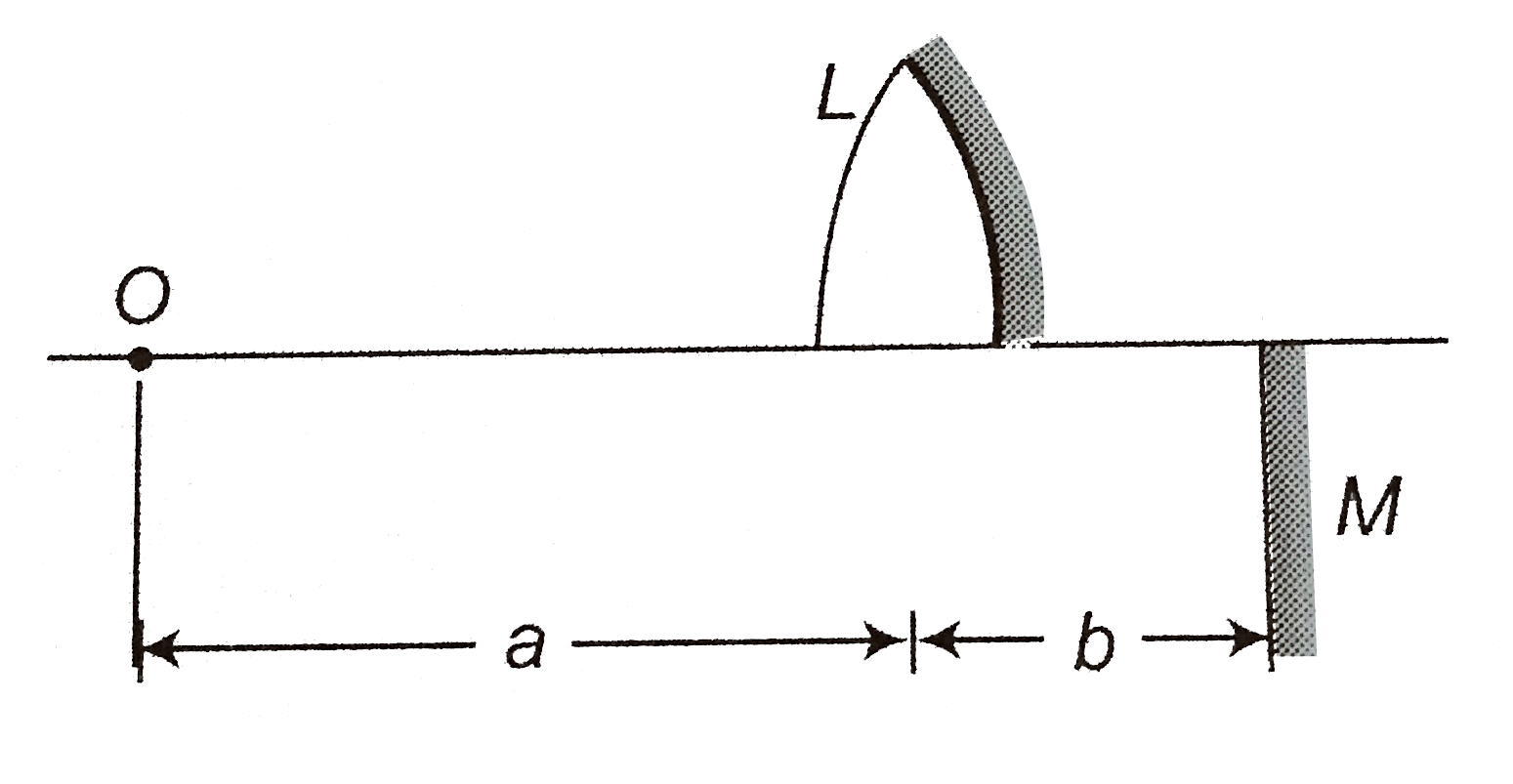In figure , L is half part of an equiconvex glass lens (μ=1.5) whose surfaces have radius of curvature R =40cm and its right surface is silvered . Normal to its principal axis a plane mirror M is placed on right of the lens . Distance between lens L and mirror M is b. A small object O is placed on left of the lens such that there is no parallax between final images formed by the lens and mirror. If transverse length of final image formed by lens is twice that of image formed by the mirror , calculate distance'a' in cm between lens and object.
_S01_072_Q01.png)
Distance of image of object O from plane mirror = a+b . Since , there is no parallax between the image formed by the silvered lens L and plane mirror M, therefore, two images are formed at the same point . Distance of image = (a+2b) behind lens. Since , length of image formed by L is twice the length of image formed by the mirror M and length of image formed by a plane mirror is always equal to length of the object , therefore , transverse magnification produced by the lens L is equal to 2 . Since, distance of object from L is a therefore, distance of image from L must be equal to 2a.
∴(a+2b)=2a⇒b=a2
The silvered lens L may be assumed as a combination of an equi-convex lens and a concave mirror placed in contact with each other co-axially as shown in figure.
_S01_072_S01.png)
Focal length of convex lens f1 is given by 1f1=(μ−1)(1R1−1R2)⇒f1=40cm
For concave mirror focal length , fm=R2=−20cm
The combination L behaves like a mirror whose equivalent focal length F is given by
1F=1fm−2f1⇒F=−10cm
Hence , for the combination u=-a , v=+2a , F=-10cm
Using mirror formula , 1v+1u=1F⇒a=5cm
_S01_072_Q01.png)
Topper's Solved these Questions
- GEOMETRICAL OPTICSBOOK - ALLENCHAPTER - GEOMETRICAL OPTICSEXERCISE - EXERCISE -01
65 Videos
- GEOMETRICAL OPTICSBOOK - ALLENCHAPTER - GEOMETRICAL OPTICSEXERCISE - EXERCISE -02
82 Videos
- GEOMETRICAL OPTICSBOOK - ALLENCHAPTER - GEOMETRICAL OPTICSEXERCISE - subjective
14 Videos
- CURRENT ELECTRICITYBOOK - ALLENCHAPTER - CURRENT ELECTRICITYEXERCISE - All Questions
427 Videos
- GRAVITATIONBOOK - ALLENCHAPTER - GRAVITATIONEXERCISE - EXERCISE 4
9 Videos
Similar Questions

As shown in figure. L is half part of an equiconvex lens (μ=1.5) whose surface have radius of curvature R=40cm and its right surface in silvered. Normal to principal axis, a plane mirror M is placed on the right of lens. A small object O is placed on left of the lens such that there is no parallax between final images formed by the lens and mirror. If transverse length of final image formed by the lens is twice that of image formed by the mirror. Calculate distance a between lens and object and distance b.
View SolutionThe optical system consișt of a thin convex lens of focal length 30cmand a plane mirror 15cm behind the lens. An object is placed 15cm in front of the lens. The distance (in cm ) of final image from the lens is
View Solution
Knowledge Check
A biconvex lens of focal length 15cm is in front of a plane mirror. The distance between the lens and the mirror is 10cm. A small object is kept at distance of 30cm from the lens. The final image is
Avirtual and at a distance of 16 cm from the mirrorBreal and at a distance of 16cm from the mirrorCvirtual and at a distance of 20cm from the mirrorDreal and at a distance of 20cm from the mirrorA biconvex lens of focal length 15 cm is in front of a plane mirror. The distance between the lens and the mirror is 10 cm. A small object is kept at a distance of 30 cm from the lens. The final image is
Avirtual and at a distance of 16 cm from the mirrorBreal and at a distance of 16 cm from the mirrorCvirtual and at a distance of 20 cm from the mirrorDreal and at a distance of 20 cm from the mirrorA biconvex lens of focal length 15 cm is in front of a plane mirror. The distance between the lens and the mirror is 10 cm. A small object is kept at a distance of 30 cm from the lens. The final image is
AVirtual and at a distance of 16 cm from the mirrorBReal and at a distance of 16 cm from the mirrorCVirtual and at the distance of 20 cm from the mirrorDNone of the above
A convex lens of focal length 15 cm is placed on a plane mirror. An object is placed 20 cm from the lens. The image is formed
View SolutionA convex lens of focal length 15 cm is placed on a plane mirror. An object is placed at 30 cm from the lens. The image is
View SolutionAn thin Plano - convex glass lens (μ=1.5) has its plane surface silvered and R is the radius of curvature of curved part, then which of the following ray diagram is true for an object placed at O ?
(O is at a distance of 2 R from the lens)
View SolutionAn equiconvex lens is prepared from a glass of refractive index, 1.5 . The radius of curvature of the surface is 0.5 m. The focal length of the lens is
View SolutionIf the plane surface of a plano-convex lens of radius of curvature R and refractive index μ is silvered, then its focal length would be
View Solution
